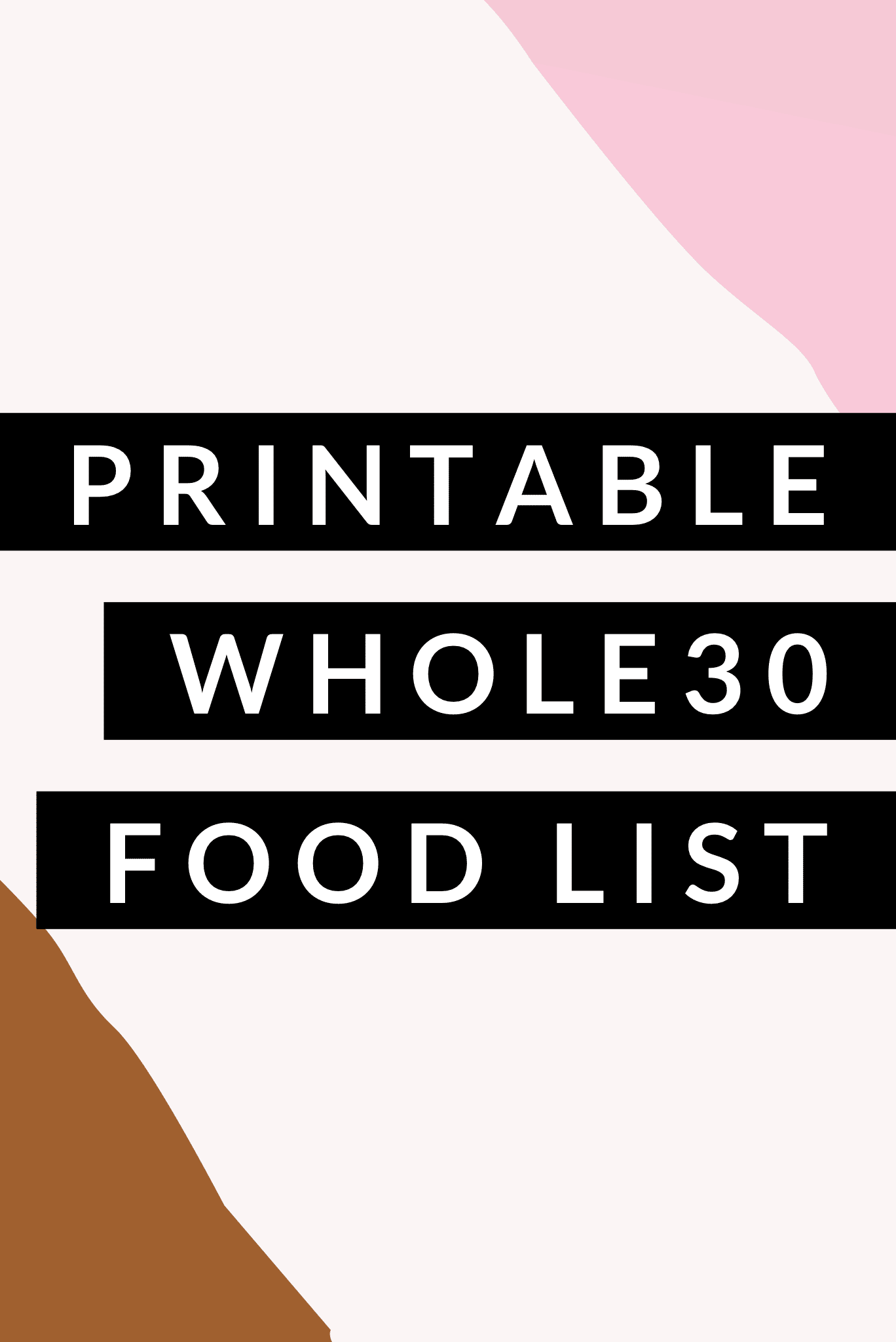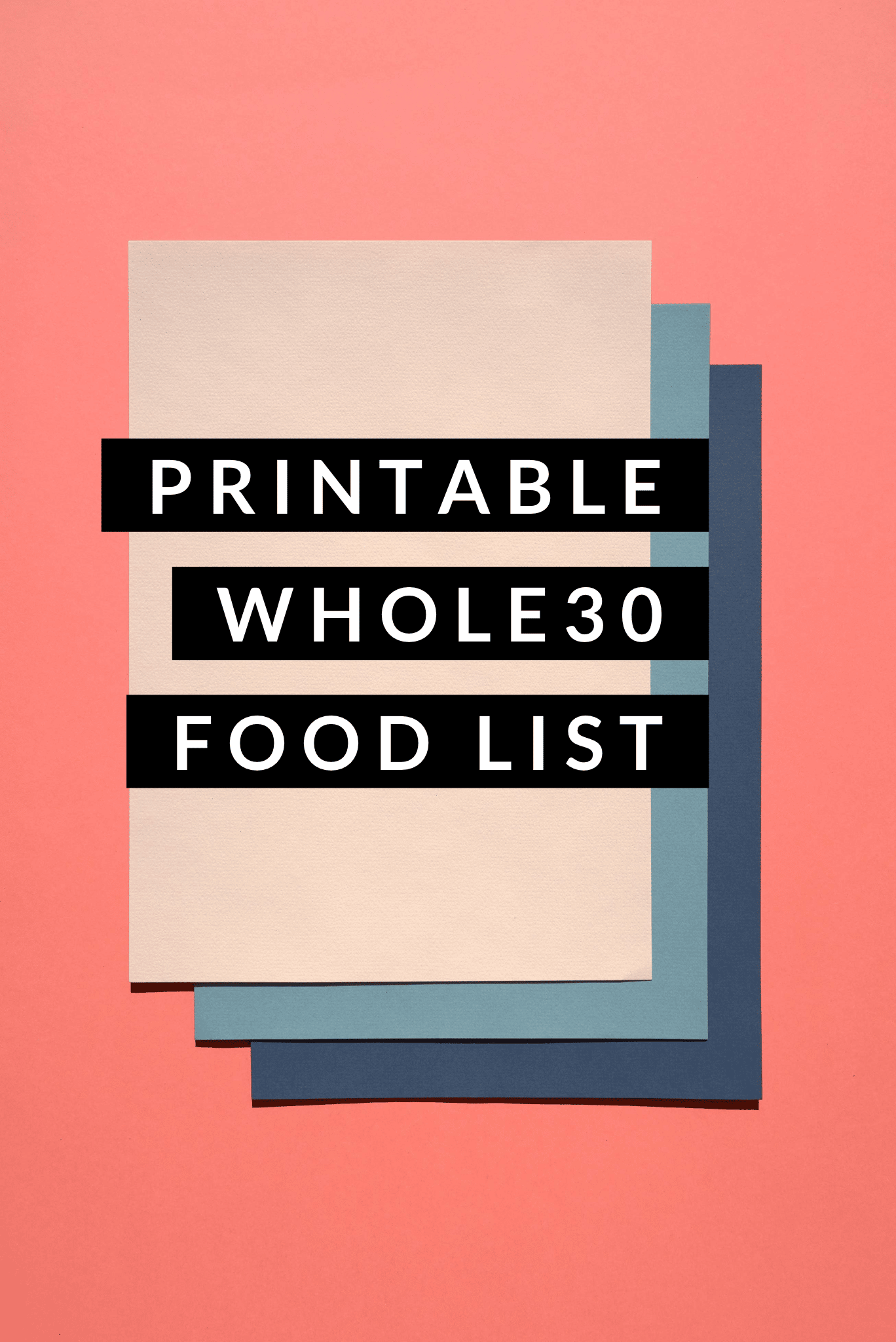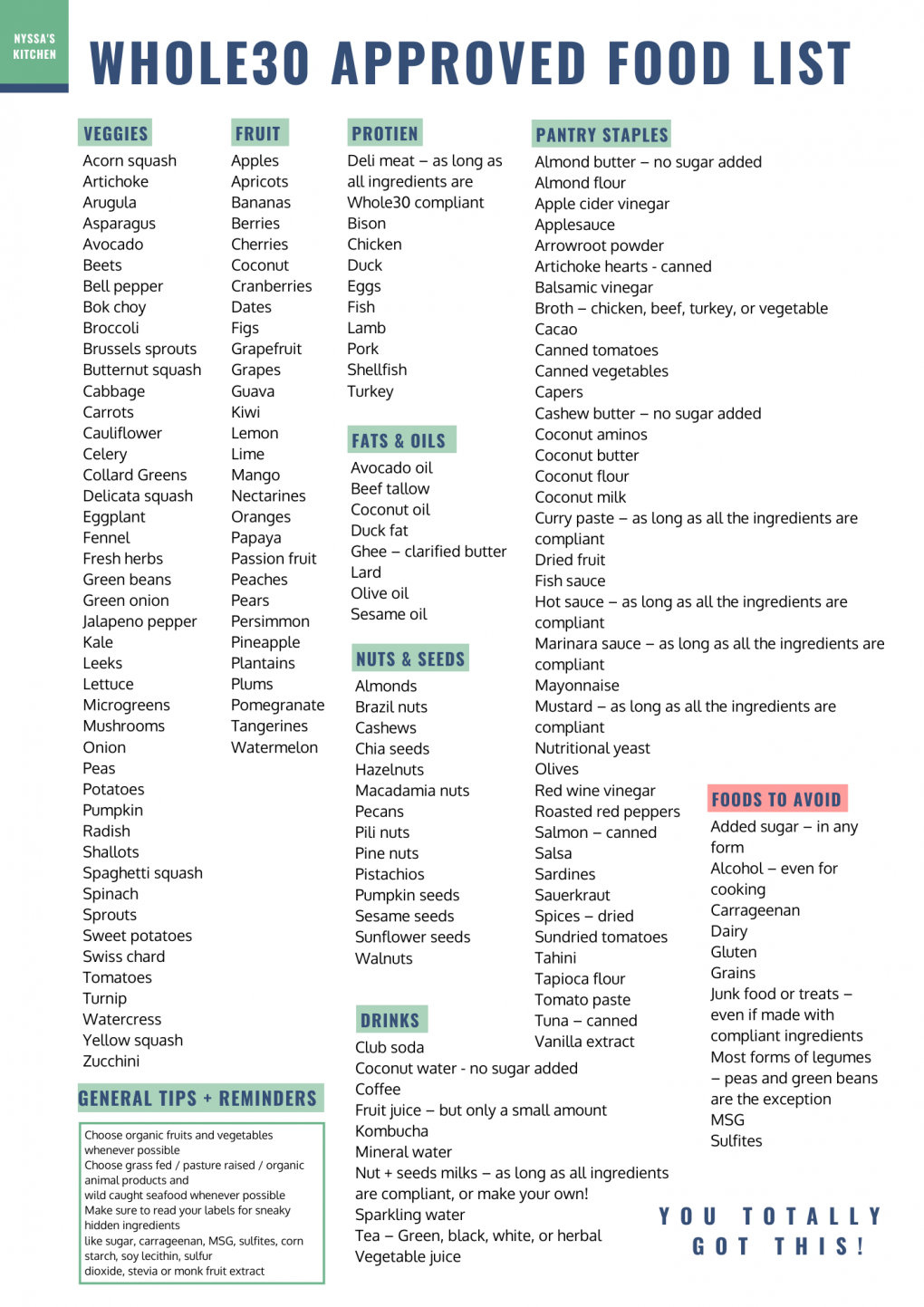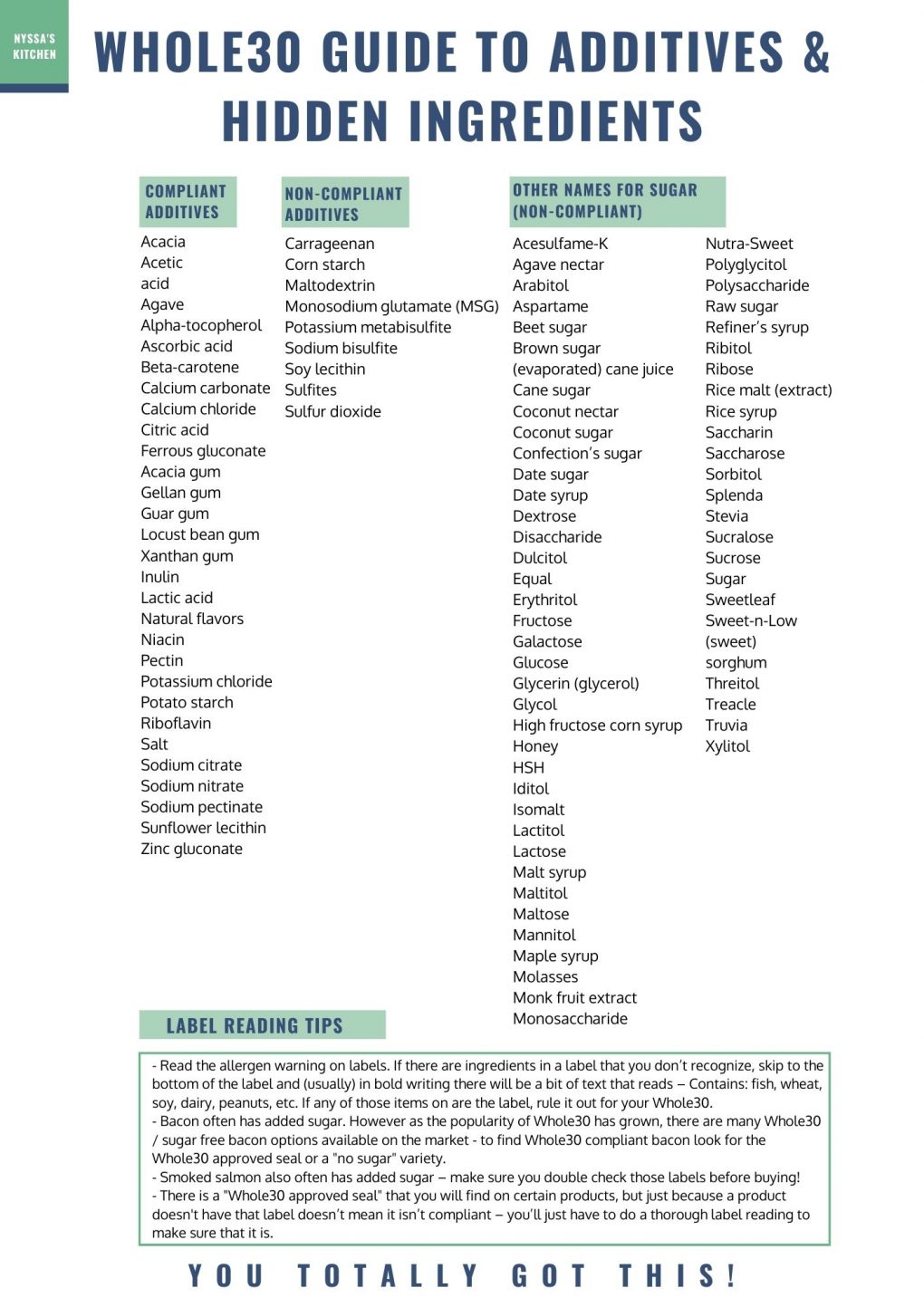Whole 30 Diet Food List Pdf
Home / Whole30 / Whole30 Food List: What you can and can't eat {with a printable PDF}


Take the guesswork out of planning for your Whole30 by downloading my Whole30 food list & Whole30 guide to additives & hidden ingredients. These printable food lists include everything you need to know to plan your meals and successfully navigate reading labels so you know exactly what you can and can't eat during your Whole30.
Whole30 Food List Guides
Download the Whole30 Approved Food List here
Download the Guide to Additives & Hidden Ingredients here
One of the most challenging things about embarking on a Whole30 journey is figuring out exactly what you can and can't eat. Especially if it is your first round of Whole30, but even if it is your second Whole30, or if it's been a long time since you've done one.
It can be super confusing, especially when you're staring down a label with ingredients that you don't even know how to pronounce! Obviously you won't encounter this issue for whole food ingredients like veggies, fruit, protein, etc., but when you're choosing a store bought mayonnaise, almond milk, canned tuna, bacon, or deli meat, things can get a little bit trickier.
Which is why I've put together this printable Whole30 food list and a guide to additives and hidden ingredients to make navigating your Whole30 easier and less stressful!
My hope is that having this complete Whole30 food list information – what you can and can't eat – in one easy to reference place will help you focus more on cooking delicious meals, and enjoying all the feel-good benefits that you're sure to find on your Whole30 journey!
First things first – What exactly is Whole30?
Whole30 is a 30 day elimination style nutrition program that focuses on taking out the main inflammatory food groups that may be causing inflammation in your body, or may be looping you in habitual eating patterns that are out of your control (hello sugar dragon!). And adding in extremely nutrient dense foods in their place!
The idea is that you remove the inflammatory food groups from your diet for long enough that your body has a chance to rest and re-set. This means that at the end of the 30 days you should be able to see how your body and mind actually feel without any of those potential triggers muddying everything up.
Although people often do lose weight during a Whole30 program, it is not designed as a quick fix diet to drop a quick 10 pounds, and in fact weighing yourself is not allowed during the 30 day program.
You'll find no calorie counting or portion control rules here. But there is a huge emphasis on tracking "non scale" victories within the Whole30 program experience – these are essentially significant wins that have nothing to do with the number on a scale and everything to do with feeling your best.
Some non-scale victories could be:
- Better sleep
- Clearer skin
- Increased libido
- Mood regulation
- Feeling less stressed
- Feeling more confident
- Fewer sugar cravings
- Improved attention span
- Less brain fog
- Improved memory
- More healthy cooking skills
- Knowing the difference between hunger and cravings
- Healthier relationship to food
- Better balance physically
- You feel stronger
- No more food guilt or shame
- More mindful eating
- Higher energy levels
- Less joint pain
- Less chronic pain
- A more regular menstrual cycle
- Less constipation / diarrhea
- Better overall digestion
- Less bloating
- Improved blood sugar regulation
- Less heartburn
- And on, and on, and on!
After the 30 days, it is recommended that you systematically re-introduce foods back into your diet to observe what food groups are triggering potential negative side effects for you. Including this step in the protocol provides you with some super valuable information to take beyond the completion of the Whole30 program, so that you have tools at your disposal to eat in a way that makes you feel amazing every single day.
Why you should do a Whole30
Outside of doing some expensive food sensitivity testing, Whole30 is the one tool that has had the most profound and lasting impact on my relationship to food. It really is mind blowing how powerful it can be in healing the body and supporting mental health!
Whole30 can be relatively affordable (and even less expensive!) if you plan it out right, and I guarantee it will give you more appreciation for what you and your body are capable of achieving 👉🏼 (Cue unexpected feelings of confidence and empowerment!).
Even though it is fairly restrictive in what you can't have, you still have a TON of options and flexibility to play around with flavors and ingredients to make some SUPER delicious meals. We definitely eat very well when we are doing a Whole30 – often better than when we're busy and "what's for dinner" becomes something of an after thought. My Whole30 food list makes it even easier to plan for meals throughout the week.
And in the end, you're giving your body the ultimate gift of food freedom. Re-setting your taste buds so that you find yourself actually craving healthy, nutrient dense, whole foods. I'm so excited to help you find that feeling!
What you CAN'T eat on a Whole30
Let's start with what you can't eat when you're doing a Whole30 – all of these items must be completely eliminated.
- Added sugar – In any form. This includes artificial sweeteners, and natural sweeteners like honey, maple syrup, and coconut sugar. You can find a complete list of other "hidden" names of sugar in this printable PDF.
- Alcohol – In any form. This also includes alcohol that you might use for cooking and and wine that may be hiding in mustard and other condiments. Read those labels!
- Dairy – Of all kinds – cheese, milk, cream, yogurt, sour cream, cream cheese, whey, butter, etc. The one exception is ghee – or clarified butter. This IS allowed on a Whole30 protocol and I bet you're going to fall in love with cooking with it.
- Gluten – A big one that typically significantly reduces inflammation in the body.
- Grains – This includes gluten free grains like corn, oats, and rice.
- Legumes – Beans of all kinds (garbanzo, black beans, white beans, etc.), lentils, and peanuts. The only exception to this rule is green beans and peas, as they don't often cause inflammation to the same degree as other legumes.
- Soy – Soy sauce, tamari, soy lecithin, tofu, tempeh, and miso are all included in this category.
- Some additives – Carrageenan, corn starch, maltodextrin, monosodium glutamate (MSG), potassium metabisulfite, sodium bisulfite, soy lecithin, sulfites, and sulfur dioxide are additives that are not allowed on Whole30. For a complete list of compliant + non-compliant additives you can check out this printable PDF.
- Junk foods, baked goods, and treats – Even if they are made with all compliant ingredients – this includes pancakes, "cookies", bread, and potato chips. Basically a food that's often eaten "with no brakes" – or eaten just because it tastes really good and not because you're actually hungry.
What you CAN eat on a Whole30
So what can you eat on a Whole30? Basically everything that's left after you eliminate all of the food groups listed above.
Click for my printable Whole30 Food List PDF
Here is a complete list of what you can eat on a Whole30:
- Vegetables – Basically as many as you can! Packing in a ton of colorful veggies is the best way to increase your nutrient dense food intake. And an easy way to "swap" out other foods like grains. If you're used to eating spaghetti and meatballs over a big bowl of pasta, try replacing the pasta with a bunch of sautéed greens, roasted veggies, or spiralized veggies instead! Choose organic whenever possible.
- Meat, seafood, poultry, and eggs – Getting an adequate amount of high quality protein is key to finding success on the Whole30 program. It will keep you full and satisfied longer in between meals. Look for grass fed, pasture raised, organic, animal products and wild caught seafood whenever possible.
- Fruit – Fruit is allowed on a Whole30 protocol, as long as you keep it at a minimum. Don't use fruit to replace your sugar cravings, and reach for low glycemic, anti-oxidant rich fruits like berries, cherries, and citrus whenever possible. Also pairing fruit with another food that has fat or protein can help prevent a spike in blood sugar.
- Natural fats – Using natural, healthy fats is an important piece of a successful Whole30. They make food taste better, and help fuel important processes in the body. The healthy fats allowed on a Whole30 program are avocado oil, olive oil, coconut oil, ghee (clarified butter), sesame oil, beef tallow, lard, and duck fat.
- Coffee – Coffee is allowed on a Whole30 diet, in moderation. Either black or with a Whole30 compliant creamer like Nut Pods or Califia Unsweetened Better Half Creamer. You could also make an easy bulletproof style coffee with compliant fats and no sweetener!
- Nuts and seeds – In moderation. Great for topping salads or adding texture and flavor to savory dishes. Also a great "emergency snack" item when paired with a small piece of fruit.
- Certain pantry staples – Now more than ever there are a ton of Whole30 friendly pantry staples on the market. Vinegar, nut and seed flours, mustard, coconut aminos, mayonnaise, olives, and spices and seasonings are just a few that are allowed. You can view a complete list of Whole30 compliant pantry staples in my Whole Approved Food List PDF. My favorite source for buying Whole30 pantry staples is Thrive Market. They have a whole category on the site that is dedicated SOLELY to Whole30 compliant products that can be delivered straight to your door. My pantry is always stocked with Thrive Market brand basics like ghee, olive oil, avocado oil, coconut aminos, and marinara sauce. Their prices literally cannot be beat, and the membership fee breaks down to $5 / month. So worth it for the money you'll save! I've been a member for years and it's highly valued resource for our whole food kitchen.
Whole30 compliant drinks
Finding YUMMY beverages to enjoy during your Whole30 is a game changer – trust me! It's really nice to have something that you enjoy sipping while you cook dinner, unwind from your day, or share a meal with a friend.
Here's a list of Whole30 compliant drinks:
- Club soda
- Coconut water – As long as it is 100% pure coconut water, with no added sugars.
- Fruit juice – Fruit juice is allowed in small amounts.
- Kombucha – Kombucha is allowed on Whole30 as long as there is no additional sugar added to the ingredients.
- Mineral water
- Nut & seed milks – As long as all the ingredients are compliant, or make your own!
- Sparkling water – Flavored sparkling waters or plain sparkling waters are both A-Okay. Also sparkling water with a small amount of fruit juice (like Spindrift) are allowed.
- Tea – Green, black, white, and herbal tea are all allowed – as long as they have no added sugar or other non-compliant ingredients.
- Vegetable juice – While it's not recommended to go crazy with fresh pressed juices, or use them to replace meals, it is okay to enjoy them in moderation. They can also make a delicious "mocktail" when mixed with some sparkling water and a few slices of citrus!
A few additional tips to get you started on the Whole30 program
Now that you know what you can and cannot eat on a Whole30, here's a few additional tips to get you started on the right foot!
- Find your WHY – In order to ensure success in a Whole30 protocol, it is so important to connect with your WHY. What are the intrinsic values that you have that have led you to take this step for your health and wellbeing? How can they guide on over the next 30 days and help you stick to the protocol even when you have a difficult moment? Coming back to your WHY is like activating your superpowers. It's like laying out train tracks so you keep you moving in the right direction no matter what comes up. This podcast offers a powerful look at finding our WHY in order to achieve ambitious goals. If you don't have a clear idea of what your why is, some prompts to figuring that out could be: What are some things right now that are causing your pain or discomfort that could be related to food? How do those pain points effect your everyday life? Inner world / emotions? Your job? The people around you? How would you feel if those pain points were no longer an issue for you, and how would you feel if you had the tools you need to create optimal health and happiness for yourself, in a way that is unique to you?
- Pick some recipes that you're excited to make – Spend some time pinning and bookmarking Whole30 recipes that sound really good, and that you're excited to make. Enjoying your food matters. It's important. And it's a huge piece of making sure that you're successful on this journey. It also helps re-train your brain to crave more healthy nutrient dense foods.
- Put in some prep work – Look through your pantry and refrigerator and toss things that are old or don't align with the elimination program. If the items are shelf stable and you plan on adding them back into your diet eventually consider boxing them up and putting them out of sight for the duration of the program. Never underestimate the power of a clean and organized refrigerator + pantry to inspire you to spend time in the kitchen!
- Plan self care – Choose some things to fill your cup that don't involve food. Some ideas could be a bath, an uninterrupted hour to read, going for a walk, stretching, meditating, a little self-care routine that you cherish, or a date night with your partner.
- Stock up on healthy drinks – Having Whole30 compliant drinks around the house that you love is a great way to curb snack cravings when you're not actually hungry (and probably just bored).
- Stock up on "emergency" snacks – Have a stash of "emergency" snacks on hand that you can eat when you can't make a complaint meal for yourself. Stock your purse, backpack, car, office so you have something to munch on until you make it to your next meal. Thrive Market is a great place to stock up on items like these – Lara Bars, Rx Bars, Seaweed, and beef jerky are all great choices.
If you're looking for some inspiration, here's some delicious Whole30 recipes to get you started!
- Healthy Whole30 Chicken Pot Pie Soup
- The Best Dairy Free Ranch Dressing
- Super Easy Nut Free Gravy
- Creamy Whole30 Smothered Pork Chops
- Super Easy Crispy Pork Stir Fry
- Whole30 Mediterranean Chicken Bowls with Creamy Tahini Sauce
- Spicy Anti-Inflammatory Turmeric Slushy
- Creamy Dairy Free Chicken and Vegetable Soup
- How to Make the Best Paleo Sloppy Joe's
Source: https://nyssaskitchen.com/whole30-food-list-what-you-can-and-cant-eat-with-a-printable-pdf/


0 Response to "Whole 30 Diet Food List Pdf"
Post a Comment